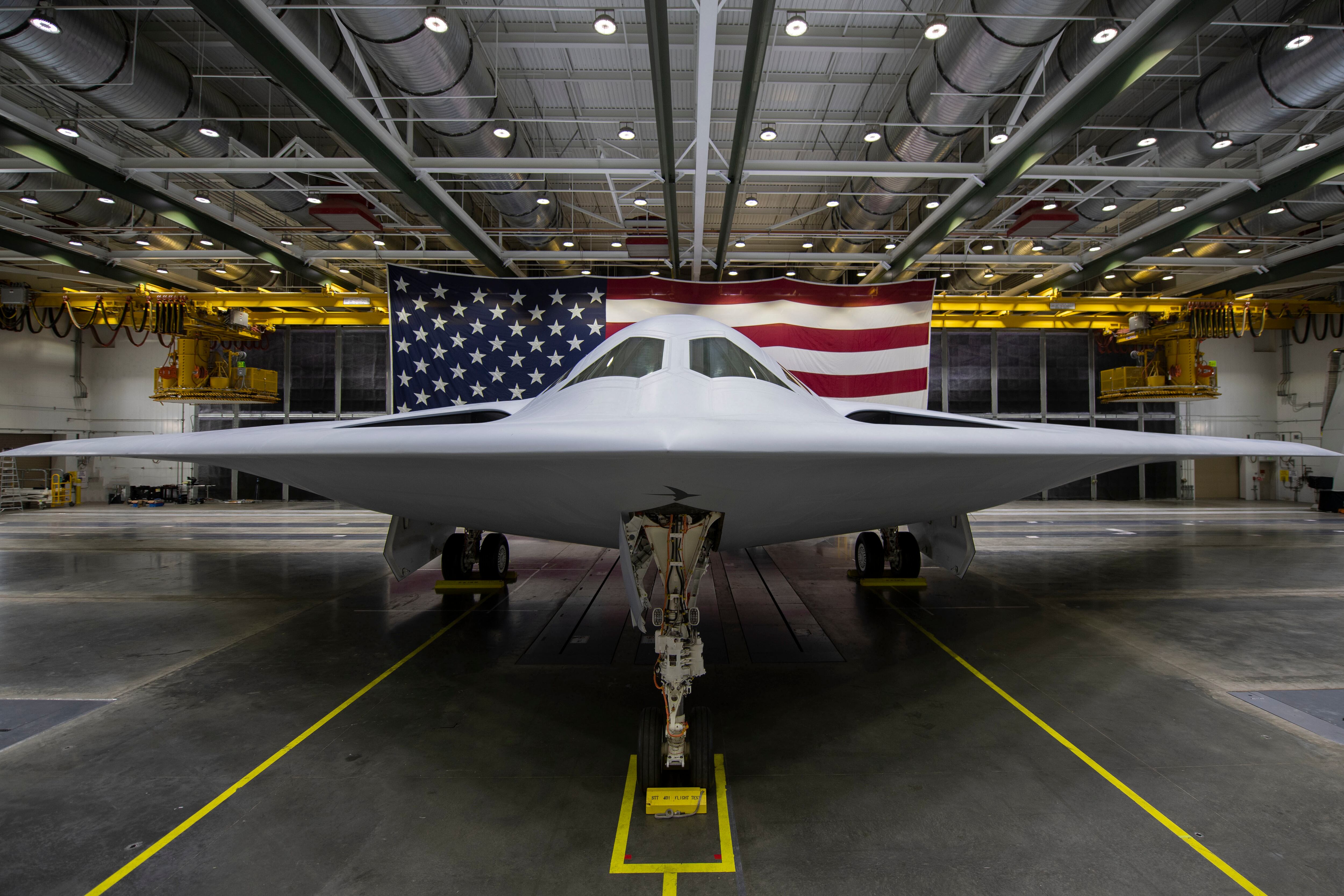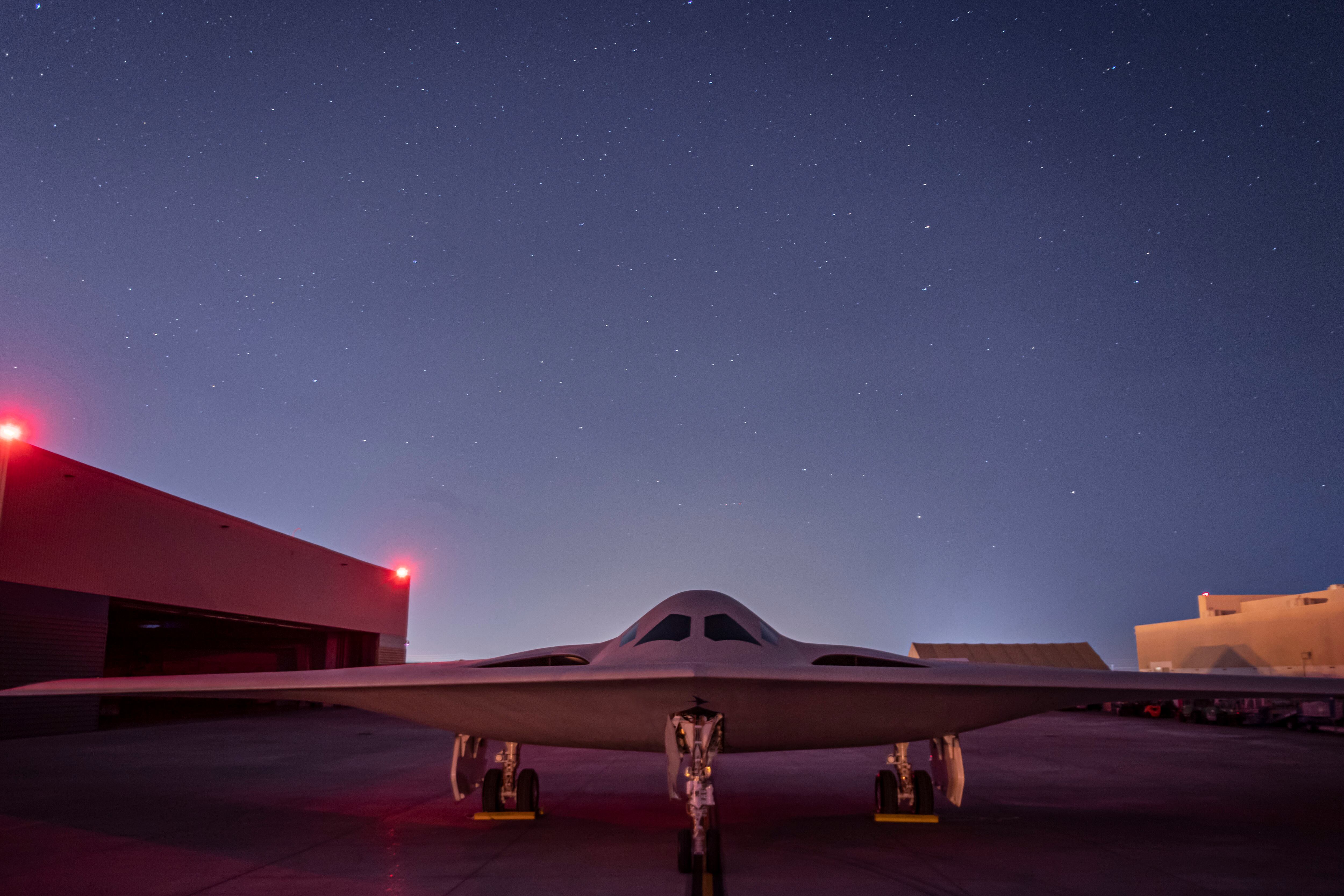PALMDALE, Calif. — For the first time in a generation, the Air Force revealed a new stealth bomber — a sleek, highly capable weapon the service hopes will be so deadly it would force leaders in China or Russia to rethink wars for decades to come.
The Air Force unveiled the Northrop Grumman-made B-21 Raider to the public Friday in a ceremony at Air Force Plant 42 in Palmdale, California, that included top defense officials, Northrop Grumman chief executive Kathy Warden, and a tribute to the storied Doolittle Raiders for whom the bomber is named.
“The audacity of the Doolittle Raiders has inspired generations of American aviators,” Defense Secretary Lloyd Austin said at the ceremony, as the imposing aircraft loomed behind him. “It’s fitting that the next chapter in American airpower is named in their honor.”
“Ladies and gentlemen, this is deterrence the American way,” Austin said.
The ceremony was attended by families of some of the Doolittle Raiders and a crowd of Northrop Grumman employees. Their mood was celebratory, as employees occasionally broke into chants of “USA! USA!” and cheered.
As dusk fell and a Northrop Grumman employee sang the National Anthem, a procession of three bombers streaked overhead — first a B-52 Stratofortress, then a B-1 Lancer with its afterburners roaring, and finally a B-2 Spirit bomber.
After Warden’s comments, in which she thanked the employees who designed and built the bomber, dramatic music played. A pair of massive hangar doors slid open, where the B-21 sat under a massive cover and bathed in fog and blue light.
The sheet dropped, revealing the bomber, and it was towed forward to the edge of the hangar as the crowd applauded.
The long-awaited debut of the B-21 marks a milestone in reshaping the Air Force’s increasingly creaky bomber fleet. It comes at a time when Russia is attempting to conquer Ukraine, China’s view of Taiwan is sparking concern, and when the U.S. military wants a highly public display to serve as a pointed warning to America’s adversaries.
And if a war with China were to break out, that nation’s recent military advancements — particularly air defenses — will require the Air Force to have aircraft that can slip undetected into enemy territory. The Air Force hopes the B-21′s advanced stealth capabilities will allow it to carry out such penetrating strike missions.

Air Force leaders envision the B-21 as the “backbone” of its future bomber force, and a key element of the U.S. military arsenal for perhaps the next half-century. When the highly classified, secretive bomber starts arriving at Air Force bases such as Ellsworth Air Force Base in South Dakota later this decade, it will arrive with the capability to carry both nuclear and conventional weapons, including standoff and direct attack munitions — and an estimated $203 billion price tag for the program.
The B-21 will be one of the top two biggest aircraft acquisitions in U.S. military history, rivaled only by the F-35, Todd Harrison, a defense budget expert and managing director of Metrea Strategic Insights, told Defense News. Other major efforts include Navy shipbuilding programs such as the Columbia and Virginia class submarines, and the next-generation nuclear missile dubbed Sentinel, previously known as the Ground Based Strategic Deterrent.
The ceremony marked the first time the Air Force has rolled out a new bomber in more than three decades, since the B-2 Spirit′s debut at the same site in November 1988. Like its predecessor, the bat-shaped B-21 has a flying wing design with no tail and minimal fuselage, which reduces drag and its signature on enemy radar.
As more B-21s are available, they will replace the aging B-1 Lancer and B-2 Spirit bombers as the Air Force moves to a planned two-bomber fleet. The Air Force plans to retire all B-1s and B-2s by the early 2030s, leaving the service with a fleet of at least 100 B-21s and Cold War-era B-52 Stratofortresses with revamped engines.
For years, the Air Force has kept details about its new bomber tightly under wraps — and aside from the view of the bomber, that did not change with its public unveiling. In briefings before the ceremony, Air Force and Northrop Grumman officials offered no new information about its capabilities.
But in his speech, Austin touted the bomber’s capabilities, which he said will allow the U.S. to deter enemies and strike targets even in highly contested airspace.
The B-21′s range will allow the bomber to carry out missions without being based in theater, or requiring logistical support in a deployment, Austin said. Its stealth capabilities will mean “even the most sophisticated air defense systems will struggle to detect a B-21 in the sky,” he added.
And its open system architecture will make it highly adaptable and “able to defend our country with new weapons that haven’t even been created yet.”
“The B-21 looks imposing,” Austin said. “But what’s under the frame and the space-age coatings is even more impressive.”
In a briefing with reporters before the ceremony, Warden said Northrop Grumman experimented with thousands of designs for the bomber in a digital environment before settling on the final version.

In a November interview with Defense News, Tom Jones, president of Northrop Grumman’s Aeronautics Systems unit, touted the B-21 as the world’s first sixth-generation aircraft. He pointed to its advanced stealth capabilities, its open-systems architecture meant to enable future modernization and its use of data-sharing technologies as part of the Joint All-Domain Command and Control, or JADC2, effort.
This B-21, number 001 and designated T1 for the first flight test aircraft, is one of six Raiders in various stages of construction at Air Force Plant 42 in Palmdale. More will follow, though Jones would not say when construction on the seventh B-21 will likely begin.
The first B-21 has undergone ground tests in recent months, as well as final assembly and application of coatings and paint before its debut.
Its next major step will be its first flight to Edwards Air Force Base in California, expected to occur sometime in 2023. Northrop Grumman has said the date of that first flight will be based on the results of future additional ground tests.
Those tests will include powering the Raider’s systems on and off, running its engines, performing taxiing test runs, and other integration tests.
Once the Raider is at Edwards, the Air Force will conduct further flight tests.
This first bomber is a production representative aircraft, essentially identical to the production aircraft that will eventually be produced by Northrop Grumman.
Jones said this differs from most new aircraft programs, which usually have their first flight conducted by a nonproduction-representative aircraft, leading to longer testing periods. He said using a production representative aircraft for the B-21′s flight tests is meant to speed up the process.
Jones also said Northrop Grumman extensively used digital testing to “burn down risk” and find and fix potential problems with the bomber in a virtual environment.
The Air Force said in an email to Defense News the B-21 is staying under its average procurement unit cost, which when adjusted for inflation is now $692 million in 2022 dollars. That represents the total cost of all procurement funding including flyaway costs, support equipment, training, spares and future modifications, the service said.
Bloomberg in 2021 reported the B-21 is expected to cost $203 billion over 30 years.
Other contractors on the B-21 include engine maker Pratt & Whitney, BAE Systems, Collins Aerospace, Janicki Industries, GKN Aerospace and Spirit Aerosystems.
The Air Force awarded the contract to build the B-21 — originally called the long range strike bomber — to Northrop Grumman in 2015, and the first rendering of the design was revealed the following year.
The program passed its critical design review in 2018. And in March 2019, the Air Force announced it had chosen Ellsworth Air Force Base in South Dakota to be the first operational B-21 bomber base, as well as its formal training unit.
B-21s will also be based at Whiteman Air Force Base in Missouri and Dyess Air Force Base in Texas.
Earlier this year, Ellsworth began construction on a 95,000 square foot hangar to maintain the B-21′s low-observable stealth coating. This was the first of about three dozen major projects at Ellsworth to prepare for the bomber’s arrival later this decade.

The B-21′s name evokes one of the most storied missions in the Air Force’s history — the 1942 Doolittle Raid. During that mission, the United States’ first strike back against Japan following Pearl Harbor, 80 airmen led by Lt. Col. Jimmy Doolittle flew 16 B-25 Mitchell bombers off of aircraft carriers to bomb Tokyo. The story of the Doolittle Raiders bolstered American morale, and forced Japan to divert forces.
The Air Force in early 2016 invited airmen to suggest names for the B-21, and later that year announced it had dubbed it the Raider. The late Lt. Col. Richard Cole, Doolittle’s co-pilot on the lead bomber, took the stage with former Air Force Secretary Deborah Lee James at the Air Force Association’s September 2016 conference to reveal the name. Cole, who died in 2019, was 101 when he made that appearance.
A Mitchell bomber was on display before the ceremony, along with other aircraft including a B-2 and an F-35.
In the pre-ceremony briefing, Air Force Chief of Staff Gen. CQ Brown said the new bomber will carry the legacy of the Doolittle Raiders forward.
“Think about the Doolittle Raiders and what they were able to do,” Brown said. “Just a handful of months after the attack on Pearl Harbor, for the very first time, you put a bomber on a carrier and struck Japan.”
“That’s innovation,” Brown continued. “That innovative spirit is sitting behind us right now.”
Stephen Losey is the air warfare reporter for Defense News. He previously covered leadership and personnel issues at Air Force Times, and the Pentagon, special operations and air warfare at Military.com. He has traveled to the Middle East to cover U.S. Air Force operations.




